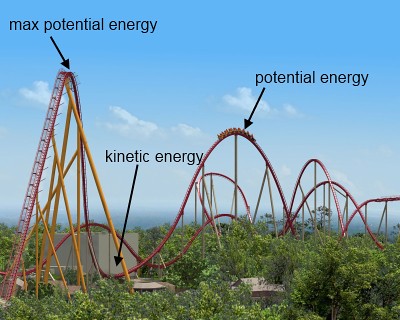Essentially, for a wooden or steel roller coaster that just has airtime hills, a train is carried up a lift chain and dropped down with gravity powering it. Two types of energy are significant in roller coasters - potential energy and kinetic energy.
A roller coaster train has more potential energy as it goes higher above the ground. Basically, the higher the lift-hill, the more potential energy the roller coaster has. At the highest point of the coaster's lift, the maximum potential energy is reached. As the train drops from that height, gravity powers the train downward, gaining velocity. At this point, the potential energy is transferred into kinetic energy. Potential energy is regained on succeeding hills.
Kinetic energy is the energy of motion. On a roller coaster, it is determined by the train's motion and its mass. Gravity induces speed of the roller coaster train, thereby creating kinetic energy. Along with potential energy, kinetic energy is part of the total mechanical energy of the coaster. Potential energy transfers into kinetic energy, and that is the basis of what powers a roller coaster.
 |
| Diamondback, a B&M hyper coaster, located at Kings' Island. |








